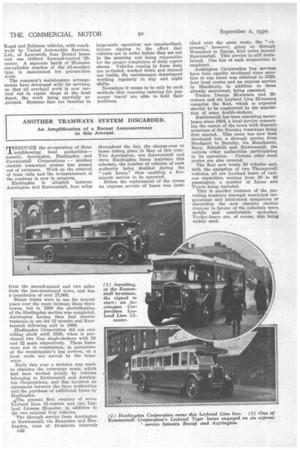ANOTHER TRAMWAYS SYSTEM DISCARDED.
Page 64

If you've noticed an error in this article please click here to report it so we can fix it.
An Amplification of a Recent Announcement in this Journal.
TI:TROUGH the co-operation of three neighbouring local authorities— namely, Accrington, Haslingden and Rawtenstall Corporations — another electric tramways system has passed out of existence. Work on the removal of tram rails and the re-instatement of the roadway is now in progress.
Haslingden is situated between Accrington and Rawtenstall, four miles from the second-named and two miles from the last-mentioned town, and has a 'population of over 17,000.
Steam trams were in use for several years over the route between these three towns, but in 1908 the electrification of the Haslingden section was completed, ACcrington having then had electric tramcars in use for 12 months and Rawtenstall following suit in 1900.
.Haslingden Corporation did not own rolling stock until 1920, when it purchased two Guy single-deckers with 26 and 32 seats respectively. These buses were put in commission, in pursiianee of the municipality's bus powers, on a local route not served by the tramways.
Early this year a decision was made to abandon the tramways route, which had been worked jointly by vehicles belonging to Rawtenstall and Accrington Corporations, and this involved an agreement between the three authorities and the purchase of additional buses by Haslingden.
14The present fleet consists of seven Leyland Lion 31-seaters and one Leyland Lioness 28-seater, in addition to the two original Guy vehicles.
The through service from Accrington to Rawtenstall, via Baxenden and Haslingden, runs at 10-minute intervals c42 throughout the day, the change-over to buses taking place in May of this year. Two Accrington, one Rawtenstall and three Haslingden buses maintain this schedule, the number of vehicles of each authority being doubled during the "rush hours," thus enabling a fiveminute service to be operated.
Before the replacement of the trams an 'express service of buses was insti
ttited over the same route, the " expresses," however, going on through Waterfoot to Bacup, four miles beyond Rawtenstall. This service is still maintained. One bus of each corporation is employed.
Accrington Corporation bus services have been rapidly developed since sanction to run buses was obtained in 1928, four local routes and an express service to Blackburn, in addition to those already mentioned, being operated.
Twelve Dennis 32-seaters and 20seaters and six Leyland Lion 32-seaters comprise the fleet, which is expected shortly to he augmented by the acquisition of some double-deckers.
Rawtenstall has been operating motorbuses since 1924, a local service connecting the centre of the town with Summit terminus of the Burnley tramways being .first started. This route has now been developed into a through service from Stockport to Burnley, via Manchester, Bury, Edenfield and Rawtenstall, the various other authorities participating in its operation. Certain other local routes are also covered.
The fleet now totals 20 vehicles and, with the exception of two Thornycroft vehicles, all are Leyland buses of various capacities, seating from 30 to 40 passengers, a number of Lions and Tigers being included.
This is another instance of the prevailing tendency amongst municipal corporations and joint-stock companies of discarding the now obsolete electric tramear in favour of the infinitely more mobile and comfortable motorbus. Trolley-buses are, of course, also being widely used.












































































































